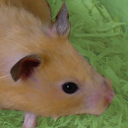Assembly
The MesAur1.0 assembly was submitted by Broad Institute on 2013/03/29 . The assembly is on the Scaffold level, consisting of 237,700 assembled into 21,484 scaffolds. The N50 size is the length such that 50% of the assembled genome lies in blocks of the N50 size or longer. The N50 length for the contigs is 22,511 while the scaffold N50 is 12,753,307.
Gene annotation
The golden hamster, or Syrian hamster (Mesocricetus auratus) is a member of the subfamily Cricetinae, the hamsters. In the wild, they are now considered vulnerable. Their natural geographical range is limited to the north of Syria and the south of Turkey, in arid habitats. Their numbers have been declining due to loss of habitat caused by agriculture and deliberate destruction by humans. However, captive-breeding programs are well established, and captive-bred Syrian hamsters are often kept as pets. They are also used as scientific research animals throughout the world.
The gene annotation process was carried out using a combination of protein-to-genome alignments, annotation mapping from a suitable reference species and RNA-seq alignments (where RNA-seq data with appropriate meta data were publicly available). For each candidate gene region, a selection process was applied to choose the most appropriate set of transcripts based on evolutionary distance, experimental evidence for the source data and quality of the alignments. Small ncRNAs were obtained using a combination of BLAST and Infernal/RNAfold. Pseudogenes were calculated by looking at genes with a large percentage of non-biological introns (introns of <10bp), where the gene was covered in repeats, or where the gene was single exon and evidence of a functional multi-exon paralog was found elsewhere in the genome. lincRNAs were generated via RNA-seq data where no evidence of protein homology or protein domains could be found in the transcript.
In accordance with the Fort Lauderdale Agreement , please check the publication status of the genome/assembly before publishing any genome-wide analyses using these data.
More information
General information about this species can be found in Wikipedia.
Statistics
Summary
| Assembly | MesAur1.0, INSDC Assembly GCA_000349665.1, Dec 2012 |
| Base Pairs | 2,504,925,039 |
| Golden Path Length | 2,504,925,039 |
| Annotation provider | Ensembl |
| Annotation method | Full genebuild |
| Genebuild started | Oct 2016 |
| Genebuild released | Feb 2017 |
| Genebuild last updated/patched | Mar 2020 |
| Database version | 115.10 |
Gene counts
| Coding genes | 18,257 |
| Non coding genes | 3,720 |
| Small non coding genes | 2,995 |
| Long non coding genes | 23 |
| Misc non coding genes | 702 |
| Pseudogenes | 306 |
| Gene transcripts | 29,936 |
Other
| Genscan gene predictions | 49,829 |
